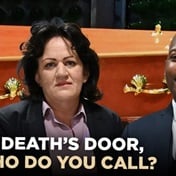
“You don’t catch a killer by simply looking at their recent act, you catch them by looking into their souls.”
This is the line she started off lecturing to her students at a university.
Before she knew it, she had to use this line to guide her to catch a serial killer in Cape Town.
As an academic, she believes that killers are created and now she has to put her theories to the test in the real world as she is a assigned a case as a police constable.
Based on a true story, Catch Me a Killer follows the life of Micki Pistorius - South Africa's first-ever serial-killer profiler played by Charlotte Hope.
In just two episodes of the series, one finds themselves deeply invested in how the Charlotte will finally put a face to the Station Strangler who has been tormenting and killing children mysteriously.
The English actress first achieved recognition for her recurring role as Myranda from the third to the fourth seasons of the HBO fantasy series Game of Thrones for three years. She then climbed the thespian ladder as a lead role of Catherine of Aragon on the Starz historical drama series The Spanish Princess in 2019 to 2020 which was her first starring performance.
Written by SAFTA (South African Film and Television Award) winning Amy Jephta to be “South Africa’s best true-life crime series, with a fresh approach”, the series ends up taking one through the case of Cleveland Killer and Stewart ‘Boetie Boer’ Wilken as well.
In a sit-down, Amy speaks about how she got involved in telling this story.
“Simon Howley and the producers had the rights to Micki’s book and were looking for a South African writer to write the first episode and see if it could be a show. Simon, Micki and I sat together and began to break the book down into episodes. This is the third adaptation of a South African book I’ve done, after Deon Meyer’s Trackers and Devil’s Peak.”
Working closely with Micki herself to bring the story to life, she raves about how incredible and fascinating she is.
“Micki is a fascinating and incredible woman. She's been through a lot. She details a lot of that vulnerability and her journey with her career and her life in her book, and she's very uninhibited. It was incredible getting to know, in small doses, the real person behind those words. You have an idea of what a forensic profiler should be, and you think of them as quite solemn and stern and traumatised and affected, but Micki is just joyous. She has a bubbliness and effervescence. She's really quirky. It was a pleasure to work with her words.”
Read More | ‘I was prepared for the role’ – Bonko Khoza as Napoleon on Red Ink
Being a woman herself, the screenwriter from Mitchell’s Plain says having a female-driven story was exciting.
“It’s always incredibly exciting to have a female-driven story, especially in a thriller. She’s in a man’s world; she’s the only female forensic psychologist at that time in the SAPS. The way she does her job is unlike how a man would do it. It was really exciting for me to figure out how a woman would think in this situation. What are the adversities that she faced? It was 1994. It was a time of discrimination, and she was underestimated. That’s my favourite kind of character to write: the character that nobody thinks is going to amount to much and then they soar. The underdog story is always the one I gravitate towards.”
Given how gruesome these stories get, she shares that she unfortunately had to immerse herself into the darkness of the story without letting it personally affect her too much.
“It was an immersion into something extremely dark, to not only understand what Micki was thinking in these moments, but also to really try and understand the heart and mind of each of these killers. To do that you have to have a lot of empathy. As a writer, you can't walk into the story already judging the people you're trying to not only humanise, but the people you're trying to complexify. I always think that as a writer it's my job to not cast judgement on any of the characters I'm writing.
“To understand and unpack them, I think we went into some pretty dark places. It’s not comparable to what Micki went through in those years that she was working as a profiler, but I think I almost touched the “edge of the edge” of what could have been going on in her mind. The thing that affected me the most are the victims, especially the children.”
The first two episodes are her favourite though because they are set in her hometown.
“The series opens in my home suburb on the Cape Flats. And I was there around that time. The story deals with the Station Strangler Killer, 1992-1994. I was in Grade 1. I remember what it felt like to be a kid at a time where there were these boys being abducted and the fear in our community. So, I could draw a lot on my first-hand feeling. My mother was a police officer at the same police station that Micki was stationed at in 1994. I was in and out of that police station. Many of the cops, who appear as characters in Micki’s book, knew me as a child.
Read More | Mudau fears going home to Limpopo this festive as storm clouds loom over ex and killer cop Rosemary
“It’s really special to me that I was able to lean into my own experience, even though this was a world away from what I was doing at the time. I was seven years old, but I remember the mythology of that serial killer being present in my childhood. I know what it was like to be on a school field playing outside when someone would yell ‘Station Strangler!’ and all the kids would just run into the school. I remember what it felt like when the people were protesting at the gates of the Mitchell’s Plain police station. A lot of those images in the show are actually drawn from my memory,” Amy takes us down memory lane.
Unlike other stories, this one just got a bit personal for her.
“My mother remembers Micki at the police station. I remember the tin cans that they put Micki and her operation in, they were like caravans or trailers on the outskirts of the police station. And I remember those being ever-present between 1992 to 1994. There was so much detail that I was able to scrounge from my mother having been there, from friends of hers, from police contacts who were there at the time, from Micki herself, from my own memory.”
For her, the show gives us just enough social and emotional context to understand what shapes serial killers. From being unloved, abandoned and abused, they find themselves being the reason why the country is du bed the murder capital of the world.



















